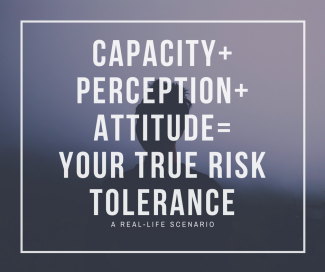
When your attitude harms your investments
By Gary Silverman, CFP®
In recent weeks, we’ve been discussing risk strategy. If you’ve missed some of the weeks leading to this, you’re in luck. Today, we’ll be looking at an example that should tie things together for you.
Capacity (your situation), Perception (your knowledge), and Attitude (your emotions) all come together to create your true risk tolerance. You’re not stuck with your current capacity. By developing a spending, saving, and investing plan you can change it for the future. Perception is the easiest to change as it only requires study. Attitude, I believe, is the most difficult to change, as most of us are hard-wired a certain way by adulthood. Even after significant market drops caused by the tech bubble burst and the recent financial crisis, research by FinaMetrica (as well as our own experience) have shown that people’s risk attitude barely budged.
To make this easier to understand, let’s look at an example. Let’s say that you have a portfolio worth $1 million and you need $4,000 from it each month to augment your Social Security income. In that case portfolios consisting only of CDs, bonds, and other lower-risk securities will not provide the income you need, taking into account taxes and inflation. Here, you’ll likely have to move half or more of your portfolio into growth investments (think stocks). Only moderate or high-risk portfolios will keep up your standard of living.
In this scenario your situation will not allow the safer portfolios. Your risk capacity shows that you’ll need a portfolio with a preponderance of stocks in it and the risk (volatility) that accompanies them. This isn’t a problem if your risk attitude can handle a higher level of risk; but what if it can’t? This is a problem—and one you’ll have to deal with.
In this scenario, if you pay attention to your capacity for risk and put more equities in your portfolio, what will you do when the market cuts stocks in half? Your risk attitude points to your propensity to sell in order to cut your losses. Even if your risk perception tells you that you should hang on until stocks recover, your emotions will be driving you in exactly the opposite direction.
I don’t know what you will do, but there are only two outcomes: selling and locking in a permanent loss or sticking with your holdings. The first will decimate your future standard of living. The latter will do the same to your mental health and potentially to your physical health for months or years. Neither is a good option.
To keep this from happening, you’ll have some hard choices to make. As I mentioned, it is unlikely you’ll change your risk attitude. That leaves your capacity. You’ll need to change the situation you’re in. And that means either finding other sources of income (not easy) or cutting expenses (not fun).
On the other hand you could do what most people do…just ignore it. In that case I suggest prayer, which is often a good idea, regardless.
This article was published in the Wichita Falls Times Record News on April 2, 2017.
Gary Silverman, CFP® is the founder of Personal Money Planning, LLC, a Wichita Falls retirement planning and investment management firm and author of Real World Investing.

